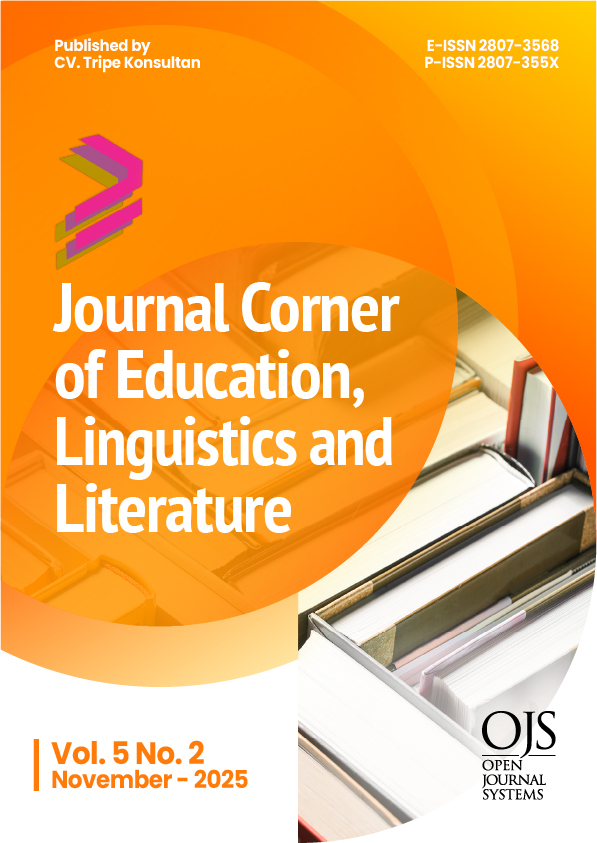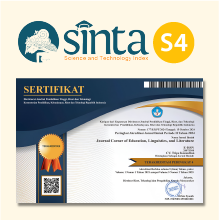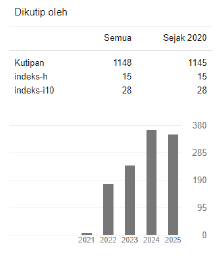Examining Script Evolution through Language Contact: The Case of Naxi Manuscripts and Chinese Characters
 https://doi.org/10.54012/jcell.v5i2.608
https://doi.org/10.54012/jcell.v5i2.608
 Abstract views: 140
Abstract views: 140
 PDF downloads: 72
PDF downloads: 72
Keywords:
Language contact, Lexical borrowing, Naxi Manuscripts, Dongba scripts, Geba scripts, Script evolutionAbstract
This study explored the impact of language contact on written languages through the case study of Chinese character borrowing in Naxi Manuscripts. Drawing from four primary corpora spanning religious, medical, and divinatory genres, the study identifies 11 frequently borrowed Chinese characters and 301 instances of borrowing through a combination of optical character recognition (OCR) and manual verification. The borrowing is in three types: phonetic, semantic, and graphic borrowing. Through two proposed indicators, "Borrowing Breadth" and "Borrowing Density", the study quantifies the extent of borrowing for different genres. Results show that medical texts exhibit the highest level of Chinese character borrowing, reflecting the extensive interaction between Naxi and Han in this field. In contrast, religious texts display the lowest borrowing rate, possibly due to their earlier composition and limited cross-cultural contact at the time. Phonetic borrowings and semantic borrowings significantly outnumber graphic borrowings, revealing that the functional features of characters were prioritized over their abstract visual forms. This paper not only expands the research on the language contact between Naxi and Han but also shows the important role of genres in linguistic integration and exemplifies how language contact can lead to script evolution.
Downloads
References
Aikhenvald, A. Y., & Maitz, P. (2021). Language contact and language change in multilingual contexts. Italian Journal of Linguistics, 33(1), 69–78. https://doi.org/10.26346/1120-2726-168
Biber, D. (1991). Variation across speech and writing. Cambridge University Press.
Coulmas, F. (2003). Writing systems: An introduction to their linguistic analysis. Cambridge University Press.
Editorial Committee of Annotated Collection of Naxi Dongba Manuscripts. (1999). Annotated collection of Naxi Dongba manuscripts. Yunnan People's Publishing House.
Friedrich, M. (2023). Lost in translation? A brief history of the study of Dongba manuscripts from its beginnings to 1945. In D. Bogin & J. van Putten (Eds.), Bon and Naxi manuscripts (Studies in Manuscript Culture, Vol. 28, pp. 269–348). Walter de Gruyter.
Haugen, E. (1953). The Norwegian language in America: A study in bilingual behavior. Volume 2: The American dialects of Norwegian. University of Pennsylvania Press.
Heine, B., & Kuteva, T. (2005). Language contact and grammatical change. In Language contact and grammatical change (pp. 123–170). Cambridge University Press.
Hemelstrand, S., Inoue, T. A tale of two scripts: Applying the principle of least complexity to simplified and traditional Chinese. J Cult Cogn Sci 9, 255–271 (2025). https://doi.org/10.1007/s41809-025-00174-w
Jiang, M., Cao, T., Tan, Y., Duan, J., & Qu, D. (2025). Semantic accessibility effects of character semantic radicals in Chinese phonograms' recognition. Frontiers in Language Sciences, 4, 1624184. https://doi.org/10.3389/flang.2025.1624184
Li, Z. (2008). A comparative study of the four writing systems of the Naxi people (Master's thesis, East China Normal University).
Liu, X., Vermeylen, L., Wisniewski, D., & Brysbaert, M. (2020). The contribution of phonological information to visual word recognition: Evidence from Chinese phonetic radicals. Cognition, 202, 104323. https://doi.org/10.1016/j.cognition.2020.104323
Lysanets, Y., & Bieliaieva, O. (2023). The use of eponyms in medical case reports: etymological, quantitative, and structural analysis. Journal of medical case reports, 17(1), 151. https://doi.org/10.1186/s13256-023-03895-0
Ma, Y., Li, Y., & Chen, S. (2024). Dongba1800 [Dataset]. Science Data Bank. https://doi.org/10.57760/sciencedb.13064
Ma, Y., Li, Y., Long, G. et al. Dataset for Single Character Detection in Dongba Manuscripts. Sci Data 12, 1075 (2025). https://doi.org/10.1038/s41597-025-05434-6
Mao, J. (2023). Doing ethnicity: Multi-layered ethnic scripts in contemporary China. The China Quarterly, 256, 977–991. https://doi.org/10.1017/S0305741023000681
Meletis, D., & Dürscheid, C. (2022). Writing systems and their use: An overview of grapholinguistics. De Gruyter. https://doi.org/10.1515/9783110757835
O’Shannessy, C. (2011). Language contact and change in endangered languages. In P. K. Austin & J. Sallabank (Eds.), The Cambridge handbook of endangered languages (pp. 78–99). Cambridge University Press.
Petersen, D. (2023). “A ‘Key’ to the Dongba Script? A Re-Appraisal of a Set of Four Dongba Manuscripts, Held by the John Rylands Library.” In A. Helman-Ważny & C. Ramble (Eds.), Bon and Naxi Manuscripts (Studies in Manuscript Cultures, Vol. 28, pp. 349-388). De Gruyter. https://doi.org/10.1515/9783110776478-013
Poupard, D. (2019). Revitalising Naxi dongba as a ‘pictographic’ vernacular script. Journal of Chinese Writing Systems, 3(1), 53-67. https://doi.org/10.1177/2513850218814405
Poupard, D. (2022). Sinoxenic writing and Chinese minority literature. Journal of Chinese Writing Systems, 6(2), 147–157. https://doi.org/10.1177/25138502211048948
Rayner, K., Pollatsek, A., Ashby, J., & Clifton Jr, C. (2012). Psychology of reading. Psychology Press.
Rogers, H. (2004). Writing systems: A linguistic approach. Wiley-Blackwell.
Sankoff, G. (2004). Linguistic outcomes of language contact. In J. K. Chambers, P. Trudgill, & N. Schilling-Estes (Eds.), The handbook of language variation and change (pp. 638–668). Blackwell.
Sankoff, G. (2018). Language change across the lifespan. Annual Review of Linguistics, 4(1), 297-316. https://doi.org/10.1146/annurev-linguistics-011817-045438
Thomason, S. G., & Kaufman, T. (2023). Language contact, creolization, and genetic linguistics. University of California Press.
Tong, X., Xu, M., Zhao, J., & Yu, L. (2021). The graded priming effect of semantic radicals on Chinese character recognition. Frontiers in Psychology, 12, 646614. https://doi.org/10.3389/fpsyg.2021.646614
Weinreich, U. (1953). Languages in contact. Linguistic Circle of New York.
Yang, L., & He, T. (2024). A study on Dongba manuscripts from the perspective of cultural geography. Journal of Chinese Writing Systems, 8(4), 313–323. https://doi.org/10.1177/25138502241299844
Yongsheng, C. (2024). Approaching the “living pictographic characters.” Chinese Publishing Journal, 23.
Yu, S. (2005). Perspectives on the etymological research of Geba script: A review of Research on the origin and development of Naxi Geba script;Chinese Character Studies, (00), 240-245.
Yu, S. (Ed.). (2022). Naxi Dongba Literature Character Interpretation Collection (Vol. 29). Chongqing University Press.
Zhou, R. (Ed.). (1950). The Book of Genesis. [Manuscript copy]. National Library of China.
Zhou, Y. (2019). Study on the associative character of Dongba Script in Lijiang Area. Open Access Library Journal, 6, Article e5255. https://doi.org/10.4236/oalib.1105255
Zisk, M. (2025). A comparison of morphogram-driven linguistic innovations throughout the Sinographic Cosmopolis and beyond. Proceedings of the Linguistic Society of America, 10(1), 5889. https://doi.org/10.3765/plsa.v10i1.5889
Downloads
Published
How to Cite
Issue
Section
License
Copyright (c) 2025 Antong Dai, Ziqing Lin

This work is licensed under a Creative Commons Attribution-ShareAlike 4.0 International License.
All articles published in the Journal Corner of Education, Linguistics, and Literature are licensed under the Creative Commons Attribution-ShareAlike License (CC BY-SA).

















